Crash in Elba at South Main and Chapel
A two-car collision is reported in Elba at South Main and Chapel streets. Elba fire police are called to the scene. No word on injuries.
A two-car collision is reported in Elba at South Main and Chapel streets. Elba fire police are called to the scene. No word on injuries.
A car accident with minor injuries is reported at Main and Jackson streets in Downtown Batavia. City fire and Mercy medics are responding. Police are on scene.
At the request of his attorney, a 26-year-old Batavia man accused in attacking a victim in a multi-person assault that led to serious injuries for the victim on East Main Street in July will be given time to consider a plea offer.
Anthony Spencer is one of two defendants identified in the case so far that led to charges against Spencer and JW Hardy of first-degree assault and gang assault.
The offer to Spencer to is to enter a guilty plea to attempted assault in the first degree.
Spencer has until Dec. 4 to make a decision.
Attorney Faris Rumi also asked Judge Charles Zambito for a reduction in bail for his client, noting that while Spencer was never charged with a crime before, he has bail set on other cases, including felony indictment and a charge in City Court, making it hard for him to gain his release.
District Attorney Lawrence Friedman objected to a reduction in bail, noting that this issue was addressed before and Spencer is facing serious charges now.
Zambito said he's already reduced the bail from $25,000 to $10,000 and wasn't aware of any change in circumstances, which would warrant another reduction in bail.
A 28-year-old Pearl Street resident tried to convince Judge Charles Zambito to send him not to jail for a year following his conviction on fourth-degree criminal possession of a weapon, following an incident in June on Central Avenue in which Danny D. Williams pulled a knife on another person.
Williams said he did it to protect a child.
He also admitted that he's had a hard time "doing the right thing" and staying out of trouble.
"I just want to be around for my kids," Williams said. "I know I need to stop hanging out with my friends. I want to be around for my kids."
Zambito admonished Williams that even if anybody else was threatened, there's nothing in the record to indicate Williams was justified in pulling a knife.
"The proper response," Zambito said, "is to call police."
Williams was initially charged with criminal possession of a weapon in the third degree, second-degree menacing, and endangering the welfare of a child. The charges stem from an incident which occurred at 8:01 p.m. on June 9 on Central Avenue, Batavia. It is alleged that Williams pulled a knife on an individual during an altercation and that there was a child in close proximity at the time.
Zambito noted that Williams has had multiple felony arrests over the past three years, and they've all been reduced to misdemeanors. He doesn't have a good record on probation, Zambito said.
"The probation department report indicates you will struggle with compliance," Zambito said.
He sentenced Williams to a year of lockup.
Here are the unofficial election totals as reported by the Genesee County Elections Commission
State Supreme Court Justice -- 8th Judicial District (Vote for 2)
Lynn Wessel Keane: 9,608
Erin M. Peradotto: 9406
There were 32 write-in votes.
District Attorney
Lawrence Friedman, 9101
There were 30 write-in votes.
County Legislature District 1
John Hilchey, 734
County Legislature District 2
Robert Bausch, 1,247
County Legislature District 3
Gordon Dibble, 1,373
County Legislature District 4
Andrew Young, 1,291
County Legislature District 5
Rochelle Stein, 1,404
County Legislature District 6
Gregg Torrey, 1,096
County Legislature District 7
John Deleo, 750
County Legislature District 8
Marianne Clattenburg, 608
County Legislature District 9
Edward DeJaneiro, 415
Gary Maha, 476
City Council At-Large (Vote for 3)
Eugene A. Jankowski, 1,437
Robert Bialkowski, 1,383
Adam Tabelski, 1,174
William Fava, 1,047
Bradley Eddy, 741
James Rosenbeck, 498
Lisa Whitehead, 492
Mark Potwora, 420
Town Justice, Alabama
Pamela J. Thurber, 299
Town Council, Alabama (Vote for 2)
Jill Klotzbach, 293
William Cleveland, 264
Town Council, Alexander (Vote for 2)
Eric Wagner, 344
David Miller, 358
Town of Batavia, Supervisor
Greg Post, 875
Town of Batavia, Town Clerk
Teressa Morasco, 953
Town of Batavia, Town Council, (Vote for 2)
Daniel Underhill, 882
Patti Michalak, 865
Town of Batavia, Town Highway Superintendent
Thomas Lichtenthal, 913
Town of Bergen, Supervisor
Ernest Haywood, 517
Town of Darien, Town Council (Vote for 2)
Anne Sapienza, 339
Mark Anderson, 341
James Starowitz, 466
Town Justice, Bethany
Joseph D. Nowakowski, 148
Thomas R. McBride, 232
Town Council, Bethany (Vote for 2)
Daniel Street, 278
Diane Fowler, 263
Supervisor, Town of Byron
Gerald Heins, 143
Roger Rouse, 329
Town Clerk, Town of Byron
Debra Buck, 557
Town Justice, Town of Byron
Daniel M. DiMatteo, 486
Town Council, Town of Byron (Vote for 2)
Suzanne Fuller, 493
Jeffrey Thompson, 486
Town Highway Superintendent, Town of Byron
Brian Forsyth, 521
Town Clerk, Town of Darien
Alice Calmes, 529
Town Council, Town of Darien (Vote for 2)
David Krzemien, 337
Michael Fix, 434
Supervisor, Town of Elba
Donna Hynes, 293
Town Council, Town of Elba (Vote for 2)
Daniel Coughlin Jr., 314
Chantal Zambito, 239
Town Justice, Town of Le Roy
Micheal T. Welsh, 863
John R. Duyssen, 942
Town Council, Town of Le Roy (Vote for 2)
Ninja-Aileene M. Calhoun, 780
David Paddock, 967
Robert Stiles, 598
James Farnholz, 1,071
Supervisor, Town of Oakfield
Carol L. Glor, 409
Town Justice, Town of Oakfield
Thomas Graham, 435
Town Council, Town of Oakfield, (Vote for 2)
Kim Wolcott, 414
Matthew Martin, 396
Town Council, Town of Pavilion (Vote for 2)
Mark Heineman, 370
Donald Oberlin, 364
Town Justice, Town of Pembroke
Edwin F. Mileham Jr., 762
Town of Council, Town of Pembroke
Edward Arnold, 711
K. Warren Clark, 699
Town Clerk, Town of Stafford
Julie Scheuerlein, 441
Michelle McEwen, 170
Town Council, Town of Stafford
Jacqueline Cavanaugh, 232
Ronald Panek, 411
Robert Mattice, 413
Town Highway Superintendent, Town of Stafford
Steven Boldt, 529
Both vehicles in an accident at Wright and Tesnow roads, Basom, reportedly rolled over and minor injuries are reported.
One vehicle is reported to be a van with two passengers. The passengers are said to be alert but disoriented. The occupant of the other vehicle appears to be uninjured. He will be evaluated because there was airbag deployment.
Alabama fire and two Mercy EMS ambulances dispatched.
UPDATE 8:31 a.m.: There are two Mercy rigs and an ambulance from Akron in route.
UPDATE 8:38 a.m.: One person is still in a vehicle but can be helped out without extrication. Another person is on the ground. A third patient is out and walking around. Responders are warned about debris in the roadway. Also, roadway signs were knocked down.
UPDATE 8:40 a.m.: The van is an extended van that is full of equipment. It was also pulling a trailer. It's on its side. A heavy wrecker will be required.
UPDATE 9:04 a.m.: Patient transported to ECMC.
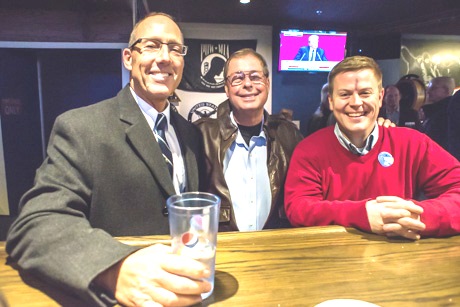
Eugene Jankowski, Robert Bialkowski, Adam Tabelski.
City Republican leaders and supporters were in a celebratory mood tonight at City Slickers on Main Street after learning that Batavia voters sent their three incumbent candidates – Eugene Jankowski, Robert Bialkowski and Adam Tabelski – back to City Council for another term.
In an eight-person race for three at-large seats, Jankowski (the sitting City Council president) tallied 1,101 votes, Bialkowski 1,069 votes and Tabelski 912 votes, according to unofficial results compiled by Republican party committee members.
Bill Fava, a former City Councilman, placed fourth with 788 votes, followed by fellow Democrat Brad Eddy (563) and the three Libertarian Party candidates – Lisa Whitehead (409), Jim Rosenbeck (407) and Mark Potwora (249).
In the contested race for the District 9 seat (City Wards 4&5) on the Genesee County Legislature, the unofficial count showed former Genesee County Sheriff Gary Maha, a Republican, drawing 364 votes to incumbent Democrat Edward DeJaneiro Jr.’s 302 votes, with 79 absentee ballots yet to be counted.
"We're very pleased with the results, and very confident that Gary (Maha) has beaten a good and tough candidate for the Legislature seat, and that the other (City Council) candidates won by a decent amount," said City Republican Party Chair David Saleh, crediting his committee for their hard work during the campaign.
Republican Message: Let's Get Back to Work
All three City Council winners said that the results indicated that the voters are happy with the job they have been doing, and that they need to stay the course.
"We appreciate all the support we have had across the city and now for us, it's back to work," Tabelski said. "We've got a lot of great things going on in the city. We've got a major focus right now on downtown revitalization. We have infrastructure projects going and, for us, it's back to work."
Jankowski said that he was glad that people are supporting what the Council has been doing, also mentioning the pending infrastructure projects and downtown revitalization plans.
"It's good to hear that the people are behind us ... and we're on the right track. We're doing what they want us to do."
Bialkowski talked about the time and effort put in by his party as a deciding factor.
"I think when the voters speak, people need to listen," he said. "One of the things that we did as the Republican party -- we worked very hard, we abided by all the laws and ordinances of the city. We didn't put our signs in parkways or put them on people's property without asking.
"We had a clear message -- we're working hard. We may not do everything right all the time, but we're sure trying."
He also gave a lot of credit to Saleh.
"On the city side, our city Chairman Dave Saleh deserves a lot of credit," Bialkowski said.
"He's worked very hard with us, and given a lot of his personal time. He's gone out and handed out materials door to door. He's had quite a few meetings. He's helped us all along the way ... And it was a real learning curve for him, too."
Eddy, Libertarians Keep Their Chins Up
Eddy, a political newcomer, was optimistic in defeat, stating that he enjoyed campaigning and kept the door open for a future run.
"I really enjoyed getting out and meeting a lot of people in the community," he said. "There’s a lot of great ideas, a lot of people that are unhappy with the progress we’ve had so far. So that kind of motivated me to getting out there and campaigning – and really getting to know the community a little better and getting my ideas out there as well."
He said the "lack of name recognition" likely hurt his chances, but he also tipped his cap to the diligence of Batavia's leaders in the area of economic development.
"(Them) getting that $10 million – they’ve been working very hard for that -- for the downtown revitalization. (It seems that voters) wanted the status quo, and wanted things to go the way that things have been … until next time."
The three Libertarian candidates, running on a platform to replace City Manager Jason Molino, understood that they had an uphill climb, but, speaking at T.F. Brown's, remained steadfast in their quest to have an impact on city government.
"It's a platform that we believed in (and) we continue to believe that," Rosenbeck said, "The people chose a different path and we wish the incumbents who were re-elected well.
"We will be back here again in two years and four years. We're making incremental gains and we expect to continue to do that."
Potwora said the Libertarian trio "did a lot of work, we canvassed a lot of people, we met a lot of good people and we feel we did make some impact on City Council."
"We did show up at a lot of City Council meetings, and we just believe that we were a good voice for the people of Batavia who supported us in this race. It's kind of tough being a third party, but we feel we did the hard work that was needed."
Maha Back in the County Ring
Maha, who retired on Dec. 31 after seven terms as sheriff, said he's ready to resume working for the people should his lead over DeJaneiro hold up.
"As you know, I retired the first of the year, I got all of my work done around the house and now I have time to do something and I feel that I want to represent the people here in Wards 4 and 5 in the City of Batavia," he said,
While saying he's not pushing for a particular type of new jail, Maha did stress that something needs to be done.
"With the Legislature there are a lot of issues out there. I know my opponent tried to make the jail an issue. And the media never talked to me about what my position was on the jail, it came from him, I tried to explain that to (a media outlet)."
He said that all options are on the table, and that the Legislature has addressed the jail issue.
"Still, the state commissioner of corrections has said you need to do something with your jail," he said.
"It could be a shared jail with another county. Orleans County at the present time hasn't committed to have a shared jail yet. The county has a study out there for a jail. It's kind of premature that it will be a shared jail or a stand-alone. That's something that the full Legislature has to address, not just me."
"I'm no longer sheriff. I'm not pushing for a new jail. My job is to look out for the taxpayers, and ... I will represent them to the best of my ability."
In another contested races:
Town of Le Roy -- Former Councilman John Duyssen defeated incumbent Michael Welsh for Town Justice by 79 votes, and Town Council: Incumbent David Paddock won one of two council seats, with the other going to newcomer James Farnholtz.
Town of Bergen -- James Starowitz and Mark Anderson won Town Council seats;
Town of Bethany -- Incumbent Town Justice Thomas McBride defeated challenger Joseph Nowakowski.
Town of Byron -- Roger Rouse over Gerald Heins for Town Supervisor.
Town of Stafford -- Newcomer Julie Scheuerlein defeated Michelle McEwen by a wide margin for Town Clerk, and incumbents Ronald Panek and Robert Mattice were returned to their Town Council posts.
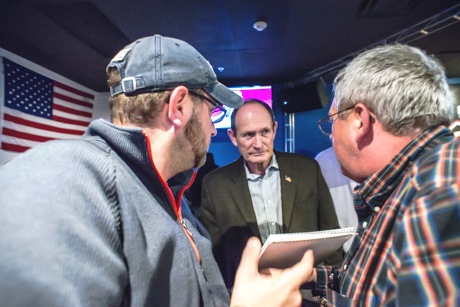
Gary Maha, center, checking out the unofficial vote total.
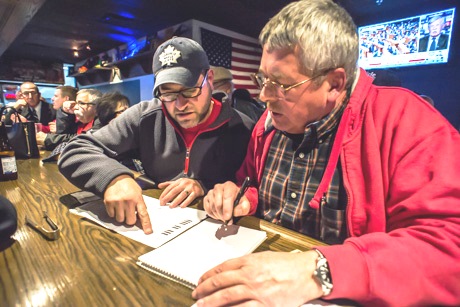
Paul Viele and Jack Taylor go over election results.
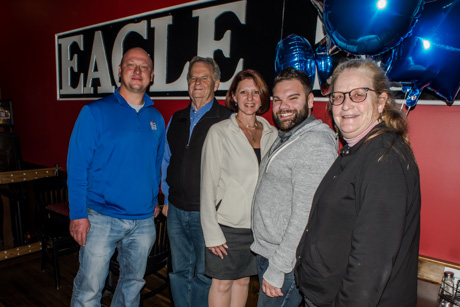
Genesee County Democrats at Smokin' Eagle in Le Roy -- Rob Stiles, Mike Welsh, Nikki Calhoun, Brad Eddy, and Anne Sapienza.
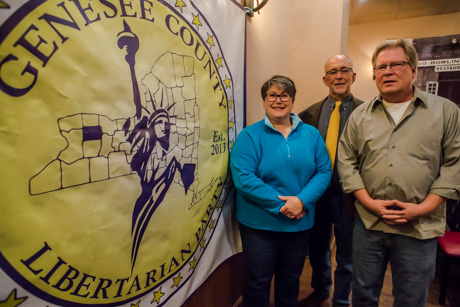
Libertarian Party candidates Lisa Whitehead, Jim Rosenbeck, Mark Potwora. Photos by Howard Owens.
City Republican leaders and supporters were in a celebratory mood tonight after learning that Batavia voters sent their three incumbent candidates – Eugene Jankowski, Robert Bialkowski and Adam Tabelski – back to City Council for another term
In an eight-person race for three at-large seats, Jankowski (the sitting City Council president) tallied 1,101 votes, Bialkowski 1,069 votes and Tabelski 912 votes, according to unofficial results compiled by Republican party committee members.
Bill Fava, a former City Councilman, placed fourth with 788 votes, followed by fellow Democrat Brad Eddy (563) and the three Libertarian Party candidates – Lisa Whitehead (409), Jim Rosenbeck (407) and Mark Potwora (249).
In the contested race for the District 9 seat (City Wards 4&5) on the Genesee County Legislature, the unofficial count showed former Genesee County Sheriff Gary Maha, a Republican, drawing 364 votes to incumbent Democrat Edward DeJaneiro Jr.’s 302 votes, with 79 absentee ballots yet to be counted.
This is a developilng story.
Two vehicles had windows smashed in at a parking lot off School Street in Downtown Batavia. City police are on scene investigating.
UPDATE 9:18 p.m.: Vandals smashed in windows on two vehicles off School Street and another two vehicles off Liberty Street. A total of three purses were stolen in the crime spree.
A car vs. deer accident with minor injuries is reported at 1315 Main Road, Corfu. Smoke is coming from a vehicle. Pembroke Fire Department is responding. The location is between Route 77 and Boyce Road. There is "debris all over the roadway," according to a first responder on scene.

Like human beings, it’s complicated, multifaceted and a work in progress.
Historians who gathered at Genesee Community College on Saturday to discuss monuments and statues of the Confederacy made that point clear.
Other issues emanating from that controversial topic were more opaque.
Should Confederate monuments be disassembled and put into a museum? Or stand as they are and “contextualized” by the addition of explanatory signage or a juxtaposing anti-memorial?
By what criteria do we evaluate the people honored? Are they more than their worst traits? Do they contribute to the public discussion beyond their role in the Confederacy?
While more and more Americans wrestle with those kinds of questions, by all accounts, the current debate is fraught with emotion. There’s a quick-tempered divisiveness that too often rapidly devolves into shouting matches or worse, culminating in the nadir at Charlottesville.
Derek Maxfield, Ph.D., GCC associate professor of History, brought together a three-man panel to weigh in on Confederate monuments. It was the last session in a day spent talking about the short shrift that history, especially local history, is getting in New York classrooms, the stifling trend of "teaching to the test," and disaster preparedness as it relates to safeguarding historical artifacts.
Speaking were:
They cited a series of articles which have been published online at a site called "The Emerging Civil War,” which offers fresh and evolving perspectives on America’s deadliest conflict. (To visit, click here.)
Mackowski provided a launching point for the sake of the discussion at GCC. He penned an article from a free speech perspective for the Emerging Civil War series because it interested him as a journalism professor, and other authors had dibs on other aspects of the controversy.
“As soon as you start saying, ‘Take down that statue because it’s offensive to me,’ to me, that’s a First Amendment issue,“ Mackowski said. "Here you have artistic expression and people saying ‘That art is offensive.’ It’s always been my understanding that one of the purposes of art is to provoke. So, of course, in some ways it’s going to be offensive to some people.”
Eula said “I couldn’t agree more that art as embodied in these statues is by definition provocative. In fact, it should be provocative. First and foremost, we need to remember that when we look at these monuments, and the discussion surrounding them, we are talking about more than monuments.
“We’re talking about how we conceive of American history…of our civil society. I think each side engaging in the conversation needs to take a moment to try and understand the other perspective, the other side."
Hamner said that although he’s disturbed by the emotional response against Confederate artwork, he diverged with Mackowski on two points.
Firstly, the question of public art versus private expression.
He said he associates the First Amendment with personal displays of art: putting a Confederate flag on your porch.
“But when it comes to public art, to me it’s not a question of free speech, it’s a question of pure politics,” Hamner said.
Therefore, Hamner advocates having a true political process to work through so that opinions are heard and a “rationale discourse” can take place regarding each monument or statue on a case by case basis.
Secondly, whether there is “instrinsic value” in a work of art strikes him as “moving the goalpost a little bit.”
Hamner said the tougher question that does need addressing is: “Do these people have intrinsic values that we need to respect – outside of their association with the Confederacy?”
Mackowski, acknowledging he purposely wrote from the viewpoint he did because it was not covered by others in the online series, agreed with his colleagues.
As we wrestle with the notion of what makes somebody worth honoring, a fear – particularly in pro-Confederate quarters – is “Who’s next?” Mackowski said, and while some argue this is a slippery slope, he allowed that “we probably need to evaluate some of these other folks.”
What do these guys represent?
It was at this point that host Maxfield brought up the stark argument, in The Emerging Civil War series, proferred by Julie Mujic (pronounced “MEW-hick”), Ph.D., adjunct professor of History at Capital University in Bexley, Ohio.
She argues that Confederate statues commemorate treason and ought to be removed.
“To sustain Confederate monuments sends the message that it’s necessary to celebrate the effort, even when that effort was malicious. The monuments must come down. They represent inequality, oppression…”
Mackowski said Mujic’s stance strikes at the heart of the whole argument: "What do these guys represent?”
“As you know, the history of the war was rewritten as soon as the war was over. And instead of it being about slavery, it starts to be about ‘noble sacrifice’, ‘doing your duty’, and ‘honor’ and ‘states’ rights’.
“So today, a lot of people refuse to look at people who served with the Confederacy as being traitors, but in fact, that’s what they were. … So do you honor that or not? That’s a very important question that we don’t have a common context for.”
Hamner has a problem with both Mujic’s argument AND the defenders of the monuments for essentially the same reason.
He cites a catch phrase, even used by President Trump in a tweet, that “You can’t change history.”
He said people tend to think of the past as objective, factual and unchanging; our historical interpretation of that past as either right or wrong.
The problem is, that “implies that the process was somehow supposed to end.”
The deal is, reinterpretation of the objective truth is going to happen with every generation, as knowledge evolves, more facts come to light, consensus migrates.
As they all conceded, historians and the citizenry can’t change the past, but the interpretations of the past must be constantly requestioned.
"I’m always struck by the curious statement that ‘We’re revising history'," Eula said. "My reaction is that ‘History is always being revised.’ "
Having said that, Eula noted that at the time most, if not all, of the statues and monuments were erected, there was no national debate about it, no consensus.
“We need to keep in mind the question: Is the removal of a monument erasing history or merely calling our attention to what is now a different interpretation of that moment in time?”
Forgotten nearly always in these discussions, Eula pointed out, are the poor whites who had not been supportive of the Confederacy from the get-go.
A whole year before the North passed a draft law forcing mandatory armed service, the Confederacy did so, which tells historians the South was not getting the numbers of volunteers for The Lost Cause that many today would like to imagine.
And the slave-holding elite, later the pardoned ex-slave-holding elite, still got the run of the place after the war.
That meant former slave owners got to become the local bankers, and pass vagrancy laws, which continued the bondage of freed men, Eula explained.
This informs today’s understanding of the time in which the statues came to be.
“My point is that it isn’t simply a straightforward proposition as to whether these statues are works of art protected by the First Amendment; whether or not there are contemporary implications for race relations in our own day.
“These are products of a specific historical moment in a specific part of the country.”
Impact Beyond the Confederacy
Eula also said many of the Confederate generals had no significance beyond their military career. That raises the question, for example, does this form a slippery-slope logic for the removal, say of the Washington Monument? No, Eula argues, because although Washington owned slaves, “his significance lies in his contribution to the construction of a new nation.”
“These (Confederate) monuments are dedicated to the memory of an elite South…seeking to destroy the United States in the name of slavery…that was as busy trampling on the rights of poor whites as it was on the slaves."
And, if the decision is made to get rid of a monument, which whether you like it or not is a “historical document,” then the process to do so must abide by some local, identifiable political construct.
To just tear down a monument, Eula said, is akin to someone walking into the Genesee County archives and saying “Well, I don’t like what’s said on this particular piece of paper, therefore, I’m going the shred it.”
“Just like for any other historical document, we have to find a way to preserve these. Whether or not they should be preserved in a public space, that’s another issue...
“These are the kinds of issues that need to be sorted out before we can make any final decision on whether or not any particular Confederate memorial stays or is replaced,” Eula said.
The operative phrase is “particular piece,” says Mackowski.
“To look at Confederate monuments as a big, monolithic one-size-fits-all sort of issue is absolutely the wrong way to go about it,” Mackowski said. "But because tempers are flaring and emotions are high, that’s sort of how people are approaching it.”
Instead, a lot of questions should be asked to inform a reasoned debate, say historians.
Who was the monument put up to honor? Why was it put up? Who put it up? When? What was the intent?
Moreover, a statue of Stonewall Jackson is a very different thing than a statue in the courthouse square that honors the local county boys who got drafted into a regiment and sent off to war.
Plus, consider that community values change, and over 150 years, they change a lot.
A book by David Lowenthal called “The Past is a Foreign Country – Revisited” describes, the panelist said, how today’s values differ vastly from those of yesteryear.
So, it behooves people today not to try and look at history through the lens of “presentism.”
“I think we’re not really talking about history at all when we talk about these monuments, we’re talking about memory,” Mackowski said.
The Sorry State of Historical Literacy
This observation prompted Maxfield to mention a problem he calls “historical literacy,” or more precisely, the lack thereof.
“I don’t want to come off as elitist about this, but the fact of the matter is we are spending less and less time in the public schools teaching history,” Maxfield said.
“We’re shoving it out of the curriculum and, in fact, Confederate history in particular, CANNOT be discussed in some Northern states.”
And vice versa; Texas comes to mind.
“That’s an unhealthy phenomenon, when you can’t look at the other side of an argument,” Maxfield said.
Meanwhile, Hamner is concerned that while people scurry to make sure history’s getting correctly written and that context is being correctly construed, there’s a gaping window open for some people to ram their political agendas through.
“One only has to look at the way Donald Trump defended the artistic value of these monuments, when he has a l-o-n-g history of development in New York City of tearing down artwork after artwork to make room for his projects.”
To wit, the construction of Trump Plaza is said to have resulted in the destruction of an Art Deco-style store that featured windows created by Spanish surrealist Salvador Dali.
None other than the Metropolitan Museum of Art in New York City waited in eager anticipation of what was supposed to be the fantabulous donation of massive Art Deco bas-relief murals from that store, only to find they had been knocked down and destroyed by Trump’s crew so as not to prolong the project by a week and a half.
The point?
“We have to be very careful that we are separating people who are using some very valid argument to shield ulterior political agendas,” Hamner said, adding “…I would hate to see a very important, intelligent conversation like this being used in a way as a shield for what I consider very, very base intentions.”
It also is not helpful that the general public does not seem to understand what the discipline of history is all about.
“A lot of what historians do is really philosophy,” Maxfield said. “Until we have the opportunity to teach more critical thinking and encourage more exploration, I’m afraid what we‘re doing, especially in the public schools, is narrow and narrow and narrow.”
Facts and Sensibilities
It’s important to remember, too, Mackowski offered, that in history, a set of facts does not equal a set of facts. Two plus two does not equal four when you are dealing with facts in history, he said.
Fact: The Union Army moved in to occupy Fredericksburg in the spring of 1862.
But that fact is viewed vastly differently by two diarists who wrote about it. One was a member of the social elite who wrote about it being this great calamity; “The Yankee invaders are here; this is awful.”
An emancipated slave saw it differently. He wrote “This is the greatest day of my life. This is the greatest thing to ever happen.”
Thus, adding together different historical perspectives over the span of a century and a half is something that can’t be “summed up” tidily.
“Before this degenerates into mindless philosophy,” Maxfield told Saturday’s attendees, garnering some comic relief, how about considering one solution offered by a historian: Leave all the monuments as they are, but just improve the interpretive signage.
How other nations have addressed the issue of historical monuments was something that Eula explored when asked to participate in the GCC panel.
“The whole issue of holocaust memorials was an obvious one” to look into, he said.
One approach he found was memorials constructed next to other memorials with different interpretations attached to them.
In the United States, for example, you could put up: a monument next to the existing one that denotes the number of slaves murdered during their enslavement; or the number of soldiers who were murdered at the Confederate prison of war camp at Andersonville, Ga.; or “the number of poor whites who couldn’t buy their way out of the draft, who didn’t support the planters’ war, and who paid for that with prison sentences,” Eula said.
Coming up with a county-by-county count of the dead, might be a way of “softening the effects of the monuments with regard to those who find them objectionable,” the official county historian said.
At this juncture, Hamner said he sees agreement about the panel’s strategies and tactics; but it comes down to his original point: the need to separate the historical element from the political one.
“I would hate to take The Lost Cause interpretation monument and then simply encase it in a new interpretation and say ‘That’s the official interpretation. Now it’s done.’ "
There is no "One Conclusive Truth"
Hamner's desire is to protect the PROCESS of public history, not the monuments themselves.
“If the political process in that community says ‘We’re putting it in a museum.’ Ultimately, I’m for that," Hamner said. "What I’m really worried about is understanding the particularities of each monument, maintaining the process of investigation, and the willingness to revise our thinking – every generation, every person.”
Which begs the question, in Eula’s mind, as to WHY we necessarily have to have ‘ONE CONCLUSIVE TRUTH’?, he asked, slapping his hand on the table as he spoke each word.
“The minute you do that it leads you down, historically, a path of dogmatism that tends to shut down democracy, that tends to shut down the expression of free ideas.”
What if we as a society never have agreement?
“So what! … Why can’t we agree to disagree and have a civil discourse?” Eula asked.
The absolute declaration of what the correct interpretation is, was called totalitarianism in the 20th century, Eula reminded the audience.
Remember, there was a time when you were either for or against McCarthyism. You were either for or against the United States entering the purported "war to end all wars,” “The Great War” -- World War I.
“That’s when a lot of innocent people get hurt and killed, for reasons to me that are absolutely senseless,” Eula said.
Mackowski countered with a “get real” argument.
Philosophizing aside, and since the notion of “contextualization” of Confederate monuments is so kosher among historians, Mackowski wanted to play devil’s advocate.
“If you’re driving down Monument Avenue in Richmond (Va.), it’s basically an auto park,” Mackowski said. “Who’s able to stop at one of those traffic islands in the middle of traffic and read context about Stonewall Jackson or Jeb Stewart or Jefferson Davis?”
Context is actually difficult to pull off in some places, he noted, and maybe even if you could pull it off, does it really match up to these giant men on giant pedestals?, he asked.
And let’s say you decide to leave it in place, what about vandalization?
To that, Maxfield chimed in with something that a historian from Texas A&M University had to offer, and that is that location does matter.
Andersonville, for example, is cited as the South’s version of a 19th century concentration camp; a place where 11,000 to 13,000 federal troops meet a grisly end under brutal conditions.
If a monument stands in a place such as this, it should be kept there, the scholar argued, even if publicly funded, because going TO that site or a battlefield is voluntary. The same cannot be said for someone who must drive past a statue that offends you every day to get to work and there’s no other route to go; that’s involuntary.
Plus, on a battlefield, historians and/or Park Service employees are there to help with knotty questions and interpretations, right?
Wrong, says Mackowski, in fact Park Service employees have largely been silent on the issue. Because taxpayers pay their salaries, they can’t really delve into it.
Some of the people best equipped to comment on this discussion have their hands tied because of politics, Mackowski said.
Nor has academia been free from constraints, Maxfield noted.
Removing monuments on a battlefield, which is essentially a giant cemetery, raises “other complexities,” according to Eula, who stressed the need for balance.
“Because we have people there, regardless of our own idealogical beliefs, who ended their life there, most likely involuntarily.”
He went on to recall how memorials to Stalin and Lenin came down in Eastern Europe in the middle of the last century.
Growing Dissent
“My point here is that, as much as it pains me to say this, there could be enough popular dissent out there regarding all these statues that no amount of discussion or legislation could change.
“It could be that our own society has so changed in the span of the last two generations in particular, that there is this huge upsurge demanding a removal of some of these monuments in the way that we saw in the Soviet Union with regard to Stalin.
“And I’m not convinced historians, even the most well intentioned, are really going to have a whole lot to say about this.”
This perspective prompted Mackowski to ask why this moment, why now?
Eula maintains that some of this popular dissent has been growing for a long time, back to the 1960s and the feelings spurred by the morass of the Vietnam War.
“It’s what I started off by saying – this is not simply about Confederate monuments,” Eula responded. “There are deeper currents here at work, and these didn’t begin recently.”
The groundswell of attention paid to the subject these days could, in part, stem from harsh “economic realities” many people face, which historians have largely been insulated from.
This means that “some of our discussions are frankly going to prove irrelevant” because they are not, rightly or wrongly, in alignment with what the populace is feeling, thinking or demanding, Eula said flatly.
Hamner said, on one hand, there’s this sort of academic/historical question of how best to contextualize Confederate artwork. Then on the other hand, there’s a deeper human question of WHY historians do what they do.
The thing that matters most of all, he said, is that – regardless of whether a decision is made to keep or do away with a monument – that a process is followed to get to the decision.
Hamner contends that the camp that says "Leave it alone. Don’t touch them" is made up of people who want to freeze time and not confront the complexity of heritage.
They are reducing human beings to their best qualities – like bravery – “a disembodied sort of character trait.”
But the opposite camp is also reductionist – making complex humans villains and the epitome of their worst characteristics.
For an example of the former, Mackowski showed a picture of the statue of Stonewall Jackson at Manassas National Battlefield Park in Prince William County, Va. (See inset photo above.)
He said Jackson is made to look like “Arnold Schwarzenegger on a Budweiser Clydesdale" … like this God of War – a horseman of the Apocalypse. In reality, Jackson was slight, modest and “would have been appalled to be portrayed this way.”
In other words, monuments are less about facts and more about “how people want to remember the Stonewalls.”
What About Bias?
A student asked the panel, “So if interpretation is the key solution, how do we select the accurate interpretation for each monument without being biased?”
The panel's collective wisdom: Finding “the objective truth” and “the right interpretation” is doomed.
Rather it is consensus itself, by interpreting and reinterpreting, that will painstakingly get you “closer and closer” to what the pluralistic outcome ought to be.
Yet Maxfield said even that is elusive because “there are progressive historians that believe progress in humankind is possible – you get closer and improve – but other historians disagree with that." That dichotomy also shapes interpretation.
Eula said he thinks it’s not possible for a historian not to be biased. So you be as objective as you can be by acknowledging your bias, “your theory.”
Since “just the facts” are not the whole story, “you look at evidence based upon your starting point. But the responsibility of the scholar is to let the audience know: This is my starting point.”
Before you can get to an interpretation of a monument, for example, you have to get people to “understand that history is relevant,” Mackowski replied.
“Unless you can get people to understand that history is not what happened in the past, but rather why the past is influencing what is going on RIGHT NOW, people aren’t going to get to that (new and improved) interpretation.”
It’s that whole issue of general historical illiteracy that Maxfield had lamented earlier.
To make meaningful headway, people have to have discussions, the historians said, not ongoing yelling matches.
“Or 140 characters of saying ‘You’re wrong!’ " Mackowski concluded.
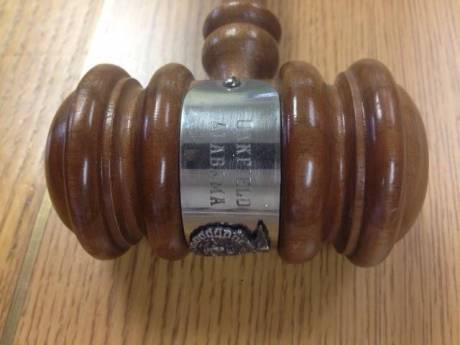
A bit of Oakfield-Alabama Future Farmers of Amercia history was returned to the current FAA chapter at the school -- now in its second year -- at the National FFA Convention in Indianapolis last month.
James Connors, Ph.D., a professor at the University of Idaho, had purchased a box of parliamentary items off of eBay and found within it a gavel inscribed with Oakfield-Alabama FFA.
When he found out O-A FFA would be at the convention, he reached out and at first members thought it was maybe a sales pitch, but after a little investigation, agreed to meet. Connors presented them with the gavel that must have belonged to the prior FFA chapter at the school.
Connors presented the gavel to OAE FFA President John Igoe, Secretary Lauren Reding, Reporter Karly Smith and Julia Uhrinek.
“We are thrilled to have a piece of Oakfield-Alabama FFA history back in our possession at school,” said FFA advisor Todd Hofheins.
Chapter members would like to learn more about the history of the gavel. If you know anything about it email thofheins@oahornets.org or call the school at 585.948.5211, ext. 4010.
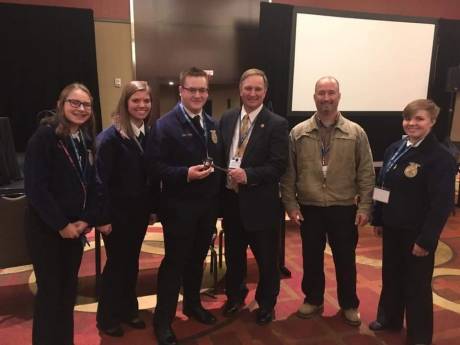
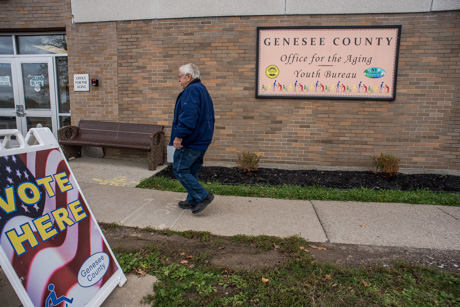
It's Election Day. Polling stations are opened throughout Genesee County. Be sure to get out and vote.
A tractor-trailer versus pole accident at a construction site on Judge Road caused power lines to be ripped down. A power company rep is on scene and lines are across construction equipment, the road and are torn from a house.
Alabama fire command is holding the assignment to remain in the fire hall. The road will be temporarily closed from Kenyon Avenue to Route 77 until the lines are removed.
No injuries are reported.
A smoke detector in the room of 66-year-old Lance Dery did not have a battery in it at the time a fire broke out at the Sunset Motel on West Main Street Road, Batavia, Saturday, according to a Sheriff's Office investigator.
Dery was found dead in the motel room when firefighters arrived at the fire scene. The fire had not spread and was confined to Dery's room. The cause of the fire appears to be a cigarette in the bed, though an autopsy has yet to be completed so officials don't know yet if Dery suffered a medical condition or died as a result of the fire, said Investigator Chris Parker.
As to the smoke detector, fire inspector and code compliance officer for the Town of Batavia, Mathew Mahaney, said the investigation is ongoing and no citations have been issued.
"As of right now, the Town of Batavia has no outstanding building or zoning violations associated with the property," Mahaney said. "We are waiting for the investigation to be completed so that we can follow up. We will follow up on similar occupancies to ensure that all places of business are complying with all procedures for life safety."
The Batavian's news partner WBTA contributed to this report.

The Tonawanda Creek crested at 11.27 feet, well into the moderate flood level, at about 10 p.m. and has since dropped to under nine feet.
Law Street is being reopened with the water's receding.
Higher crests over the previous 10 years are 11.94 feet in December 2013 and 11.72 feet in December 2008. The highest crest on record was 14.5 feet, March 1, 1942.
Below are two flood photos, from North Pembroke Road, submitted by Michael Quaranto.


Area league bowling scores for the week of Oct. 30 are posted on the Pin Points page (see tab at the top of the home page) -- and there were some big ones, led by a 300 game and 762 series by Curtis Foss of Medina in the Friday Mixers League at Oak Orchard Bowl in Albion.
Other "high rollers" were Gregg Wolff of Batavia, 298--729 in the County Line Stone League at Scopano's Lanes in Oakfield; Jason Nickerson, 297--738 in the Sneezy's Monday Night League at Oak Orchard Bowl, and Michele Larson, 267 game and 732 series in the Synergistic Online Solutions Monday Night Football League at Mancuso Bowling Center in Batavia.
Watch for Mike Pettinella's Pin Points bowling column, which will be published this Thursday.
A truck vs. utility pole accident is reported in area of 7561 Gilbert Road in Bergen.
No word on injuries.
Pole is down and blocking the roadway. Wires down
Bergen fire dispatched.
A tractor-trailer has reportedly jackknifed on Route 20 near Smithly Road, Darien.
Darien fire dispatched.
Route 20 is blocked.
UPDATE 4:22 a.m.: Alexander fire requested to shut down traffic at Route 98. The trailer is on its side.
A spokesperson for the Department of Energy contacted The Batavian today to explain that the reason 1366 Technologies hasn't received its loan guarantee yet is that the company has yet to meet all the criteria of the original 2011 loan guarantee agreement.
On one hand, that appears to be true. The DOE says 1366 needs to secure $100 million in private investment. That hasn't happened yet. The second qualification, that 1366 has yet to select a site for its factory, is a matter of how the DOE interprets 1366's agreement with New York to build at the STAMP site in Alabama.
Asked about the seeming incongruity of 1366 announcing a site selection in 2015 and the DOE now claiming no site has been selected, the spokesperson said, "In a meeting with DOE officials last month, 1366 Technologies stated that it was considering three possible locations for their facility, of which one location is in New York."
Laureen Sanderson, speaking for 1366 Technologies, said 1366 is committed to building in Genesee County but the company also let the DOE know that if the loan guarantee wasn't approved, the company would have to initiate its contingency plans, which likely means building a plant in another country.
"Of course, we discussed contingency plans with DOE," Sanderson said. "That's par for the course when talking with a partner, but our focus remains on New York."
She added, "What’s important to recognize is that our commitment to New York remains. That's the site we selected in 2015. State and local officials have been wonderful. We’re doing everything we can to make that site a reality."
What both sides can agree on is that negotiations on the loan guarantee agreement are ongoing and active. Sanderson characterized the discussions as positive and productive.
"We have a shared goal with the Department of Energy to create U.S. manufacturing jobs," Sanderson said. "That's what we both want to do and that’s what we hope we can achieve together with the Department of Energy."
The spokeswoman confirmed there was a loan guarantee finalized in 2011 but said it was contingent on 1366 securing $100 million in equity financing and finalizing a location for its manufacturing plant.
Sanderson confirmed 1366 has so far raised only $89 million but emphasized again the company is committed to New York and creating U.S. manufacturing jobs.
The negotiations with the DOE are necessary, in part, because the solar industry has continued to evolve since 2011.
"A lot has changed in the solar industry but what hasn’t changed is the strength of the technology," Sanderson said.
The lag time between announcing the company's plans to build at the STAMP site and now, Sanderson said, has enabled the company to improve the energy efficiency of its solar wafers, working with partner Hanwha.
"The technology has only gotten better," Sanderson said. "Our technology not only improves the manufacturing process and reduces costs but every wafer we produce is a better product."
The proprietary technique development by 1366 at MIT's labs in the Boston area uses molten silicon to make a wafer, rather than the cutting and grinding process the solar industry has used for 40 years. This reduces waste and energy used to make wafers.
Right now, 1366 only has a demonstration production facility in Medford, but the company, working with Hanwha, has continued to improve efficiency by .08 percent annually, making 1366's wafers the most efficient in the industry, Sanderson said.
When the company can go into full production, it can continue to make efficiency gains as well as work with solar panel companies to find other uses for this new technology. The company will be able to make thinner wafers that are strong and more flexible. Current wafers are too brittle for thin, flexible uses.
"Because we are able to work at the melt level, we are able to introduce new features the industry has long wanted but can't achieve," Sanderson said. "There is only more innovation and discoveries to be had through the manufacturing process."
When 1366 announced its intention to build in Alabama, CEO Frank van Mierlo cited lower cost, clean hydropower from Niagara Falls as an attraction to the location. Sanderson added another reason 1366 wants to stay in the United States, if at all possible -- a superior silicon supply chain.
"Our technology is the first major change in the solar industry in more than 40 years," Sanderson said. "We solved a manufacturing challenge that the industry has wanted to solve for 40 years. There is a lot of technological strength in the U.S. supply chain and with that strength, the U.S. has a real chance to establish manufacturing leadership."
Copyright © 2008-2022 The Batavian. All Rights Reserved. Privacy Policy | Terms of Service